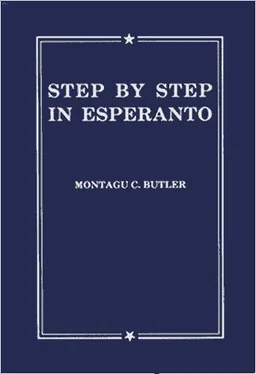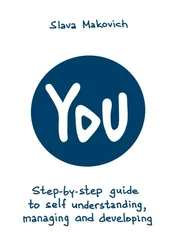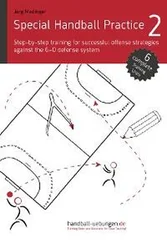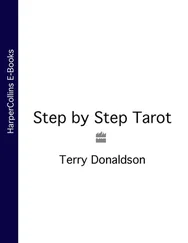(c) Kio estas en laskatolo (valizo, nesto, taso, teo)? (En la skatolo …) En kio estas lamono (floro, lakto, kafo)?
22. (a) ESTASalso = are. Butero kaj sukero estas en la kuko, Butter and sugar are in the cake. En la skatolo estas( there are ) libro kaj pupo.
(b) Pasero kaj ovo estas en la nesto. En la domo estas kato kaj hundo. Cream and sugar are in the tea. In the vase are a rose and a tulip. In the river are a hippopotamus and a crocodile.
23. arbo, tree ; kampo, field ; plafono, ceiling ; benko, bench, form ; korbo, basket ; planko, floor ; breto, shelf ; kreto, chalk ; tabulo, board, plank
Sur la strato estas tramo, In (=on) the street there is a tram ( Tramo estas …, Estas tramo …). Sur la plafono estas araneo. On the ceiling is a spider . Sur la nigra tabulo estas poemo, On the black-board is a poem.
24. (a) The city is on a mountain. A box is on the shelf. On the field is a tree. (There) is a violin on the piano. Tea and coffee are on the table. On the floor is a basket. The black cat is on the chair ( seĝo: pronounce sedge-oh ).
(b) Make sentences with sur and the following pairs of words: Sukero … kuko. Hundo … mato. Rivero … boato. Benko … valizo. Tablo … vazo. Akvo … birdo.
(c) Kio estassur la tablo? en la libro? sur la strato? en Irlando? sur la planko? en la skatolo? sur la breto? en la korbo? sur la seĝo?
(d) Sur kio estas lahundo (urbo, arbo, kreto, seĝo, tablo, valizo, skatolo)?
25. Kreto por la tabulo. Taso por teo. A lamp for the table. A box for the doll. A glass for milk. An omnibus for the family. Sugar and cream for the coffee. A shelf for the candle. A book for father.
26. KIE, Where. Kie estas la patro? ( Or , Kie la patro estas?) (La patro estas en Parizo). Kie estasAmsterdamo? Dublino? Edinburgo? Toronto?
27. TIE, there (=in that place, over there, yonder) .
Do not confuse this with the untranslated “there” in par. 20, which does not mean “in that place”.
(a) Kie la bildo estas? La bildo estas tie ( pointing ), sur la muro( wall ). Kie la fenestro( window ) estas? La fenestro estas tie, en la muro. Kaj estas fenestro tie, en la pordo( door ).
(b) Kie estas labirdo? nesto? konduktoro? omnibuso? teo?
(c) ( Answer with tie, pointing ). Kie labenko (libro, lampo, nigra tabulo, plafono, piano, planko, pordo, seĝo, strato, valizo) estas?
«Mi», «li», «ŝi», «ĝi», «vi»
28. Mi, I. Li, he. Ŝi, she. Ĝi, it. Vi, you. Mi, ŝi,have the sound of me, she. Liis the French il backwards. Viis like the French vous. Ĝisounds as in gee-gee.
mi estas= I am
li estas= he is
vi estas= you are
Unlike English, Esperanto makes no change in the verb for “number” or “person”. It is like saying I is, he is, you is.
KieFrank (Mary, la tablo, vi, mi) estas? Ans. : Li (ŝi, ĝi, mi, vi) estas …
29. After “prepositions” (words like en, por, sur) English alters I to me; she to her; and he to him. Esperanto makes no such change. Tio estas por mi( for me ); por li, for him ; por ŝi, for her.
The flower is on her (him). That is a letter for me.
30. Mi estas Tom Smith. Kiuestas mi? ( Or , Kiu mi estas?) (Vi estas T.S.). Kiu ŝi estas? (Ŝi estas Ethel Brown). Kiu li estas? Kaj vi? (N.B. Pronounce kee-oo ; not kee-you ).
31. In most languages new words are formed from other words by adding syllables called “affixes”. Thus from kind we make unkind, kindness, unkindness, by adding the affixes un, ness. An affix ( afikso) placed before the main word (like un- ) is called a “prefix” " (prefikso);one at the end (like ‑ness ) is called a “suffix” (sufikso). [9]
In English the use of affixes is irregular. We say heroine, but not fatherine, priestine; unkind, but not unrich, ungood; kindness , but not honestness. In Esperanto, however, every affix may be joined to any root with which it makes sense. In this way, from every Esperanto root you can make a number of words without having to learn them.
32. The suffix ‑INshows the fem inine . (Cp. hero, hero ine, Joseph, Joseph ine ). Thus, from bovo, ox , we get bovino, cow . Viro, man , virino, woman . Amiko, friend , amikino, lady friend . Skolto, scout ; skoltino, girl guide . Edzo,husband (When he weds, he’s an edz!); edzino, wife . Patrino, mother ; kanariino, hen canary ; poetino, poetess .
33. (a) Say the feminine of Emilo, Ernesto, Georgo, Henriko, Karolo ( Charles ), Klemento, Kristo, Roberto, Tomaso, Viktoro, Vilhelmo ( William ).
Modelo: La knabo [10]kaj la knabino, the boy and the girl. Similarly: La filo (patro, kato, koko, kamelo, leopardo, krokodilo, aligatoro,hipopotamo) …
(b) Use ino after the following roots, and translate: arane, bird, hund, idiot, kamarad, kok, paser, tigr, vultur.
(d) Conductress, cow-elephant, hen-eagle, heroine, queen-bee, lioness.
34. This shows the male sex. When talking about animals, it is generally not necessary to specify this: e.g., kato= cat (in general). But vir-can be used when required. Virkato, Tom cat; katino, she-cat. Virbovo, bull; virpasero, cock-sparrow.
Virhundo, viraglo. Bull-elephant, drone-bee, cock-canary.
35. Do not mix these words up.
KIO li estas?(Li estas knab o) (16).
Читать дальше












